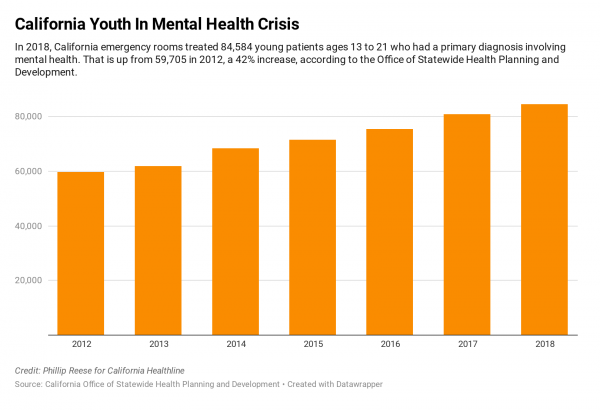Less than a decade ago, the emergency department at Rady Children’s Hospital in San Diego would see maybe one or two young psychiatric patients per day, said Dr. Benjamin Maxwell, the hospital’s interim director of child and adolescent psychiatry.
Now, it’s not unusual for the emergency room to see 10 psychiatric patients in a day, and sometimes even 20, said Maxwell. “What a lot of times is happening now is kids aren’t getting the care they need, until it gets to the point where it is dangerous,” he said.
ERs throughout California are reporting a sharp increase in adolescents and young adults seeking care for a mental health crisis. In 2018, California ERs treated 84,584 young patients ages 13 to 21 who had a primary diagnosis involving mental health. That is up from 59,705 in 2012, a 42% increase, according to data provided by the Office of Statewide Health Planning and Development.
By comparison, the number of ER encounters among that age group for all other diagnoses grew by just 4% over the same period. And the number of ER encounters involving mental health among all other age groups — everyone except adolescents and young adults — rose by about 18%.
The spike in youth mental health visits corresponds with a recent survey that found that members of “Generation Z” — defined in the survey as people born since 1997 — are more likely than other generations to report their mental health as fair or poor. The 2018 polling, done on behalf of the American Psychological Association, also found that members of Generation Z, along with millennials, are more likely to report receiving treatment for mental health issues.
The trend corresponds with another alarming development, as well: a marked increase in suicides among teens and young adults. About 7.5 of every 100,000 young people ages 13 to 21 in California died by suicide in 2017, up from a rate of 4.9 per 100,000 in 2008, according to the latest figures from the U.S. Centers for Disease Control and Prevention. Nationwide, suicides in that age range rose from 7.2 to 11.3 per 100,000 from 2008 to 2017.
Researchers are studying the causes for the surging reports of mental distress among America’s young people. Many recent theories note that the trend parallels the rise of social media, an ever-present window on peer activities that can exacerbate adolescent insecurities and open new avenues of bullying.
“Even though this generation has been raised with social media, youth are feeling more disconnected, judged, bullied and pressured from their peers,” said Susan Coats, a school psychologist at Baldwin Park Unified School District near Los Angeles.
“Social media: It’s a blessing and it’s a curse,” Coats added. “Social media has brought youth together in a forum where maybe they may have felt isolated before, but it also has undermined interpersonal relationships.”
Members of Generation Z also report significant levels of stress about personal debt, housing instability and hunger, as well as mass shootings and climate change, according to the American Psychological Association survey.
Resources to prevent mental health crisis among youth are often lacking.
“We’re not doing a great job with … catching things before they devolve into broader problems, and we’re not doing a good job with prevention,” said Lishaun Francis, associate director of health collaborations at Children Now, an Oakland-based nonprofit.
Many California school districts don’t have enough school psychologists and don’t devote enough resources to teaching students how to cope with depression, anxiety and other mental health issues, said Coats, who chairs the mental health and crisis consultation committee of the California Association of School Psychologists.
In the broader community, medical providers also are struggling to keep up. “Many times there aren’t psychiatric beds available for kids in our community,” Maxwell said.
Most of the adolescents who come into the emergency room at Rady Children’s Hospital during a mental health crisis are considering suicide, have attempted suicide or have harmed themselves, said Maxwell, who is also the hospital’s medical director of inpatient psychiatry.
These patients are triaged and quickly seen by a social worker. Often, a behavioral health assistant is assigned to sit with the patients throughout their stay.
“Suicidal patients — we don’t want them to be alone at all in a busy emergency department,” Maxwell said. “So that’s a major staffing increase.”
Rady Children’s Hospital plans to open a six-bed, 24-hour psychiatric emergency department in the spring. Improving emergency care will help, Maxwell said, but a better solution would be to intervene with young people before they need an ER.
“The ED surge probably represents a failure of the system at large,” Maxwell said. “They’re ending up in the emergency department because they’re not getting the care they need, when they need it.”
Phillip Reese is a data reporting specialist and an assistant professor of journalism at California State University-Sacramento.














